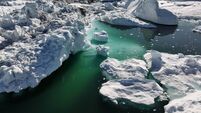Marine heatwaves leading to mass deaths in seabirds

Puffins, auklets, murres, and shearwaters were particularly vulnerable, with seabird deaths most likely exceeding 250,000 about once every 10 years.
Marine heatwaves such as the one off Ireland's coast in recent weeks led to mass deaths in seabirds, American research has found.
The middle of last month saw sea temperatures off the west of Ireland and the north-east of England rise to several degrees above normal, easily breaking records for the time of the year.
Met Éireann said June was not only the hottest ever on record, but also that the elevated sea-surface temperatures and marine heatwave experienced in the month could be linked to recent extreme rain and thunderstorms such as those that damaged parts of Kerry in a sudden burst of flooding.
Ireland's meteorological service said the "world’s oceans act as earth’s great heat reservoir, and have absorbed over 90% of the excess heat trapped by greenhouse gas emissions".
However, it warned while this has slowed the rate of atmospheric warming, it has come at a cost — the intensification of marine heatwaves.
"These extreme events can have devastating consequences, and can potentially cause widespread bleaching of coral reefs, the proliferation of harmful algal blooms, the displacement of marine species, and the disruption of entire food chains," it said.
Research from the University of Washington on the US west coast has now found seabirds are some of the biggest casualties of marine heatwaves.
Scientists examined data from beaches from central California to Alaska over the past 30 years, finding persistent marine heat waves lead to massive seabird deaths months later.
The results of the study, published in the journal , were based on 90,000 surveys of 106 species on more than 1,000 beaches.

Puffins, auklets, murres, and shearwaters were particularly vulnerable, with seabird deaths most likely exceeding 250,000 about once every 10 years.
Those type of catastrophic mass deaths have now sped up dramatically as marine heatwaves intensify, the study found.
Between 2014 and 2019, five events met this mortality threshold, the UW team found.
Professor of aquatic and fishery sciences at the University of Washington and co-author of the paper Julia Parrish said: "We find a dramatic delayed effect. A warmer ocean, and certainly a suddenly warmer ocean as happens during an El Niño or a marine heatwave, will result in the death of hundreds of thousands to millions of marine birds within one to six months of the temperature increase.”
Lead author and research scientist in aquatic and fishery sciences, Timothy Jones said the death rate was unprecedented.
"This type of massive die-off can be compared to a catastrophic storm that we would usually expect once per decade — they happen, causing massive damage, but usually there is enough time for areas to recover.
Climate change as well as the return of the El Niño weather phenomenon are the cause of the current global record-breaking temperatures, scientists believe.
El Niño refers to warming of the ocean surface, or above-average sea surface temperatures, in the central and eastern tropical Pacific Ocean, affecting the rest of the world when it happens.
CLIMATE & SUSTAINABILITY HUB














